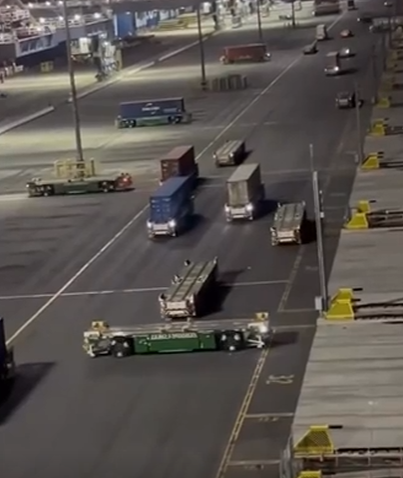In the rapidly advancing field of port automation, foundational technologies like millimeter-wave (mmWave) radar are playing a pivotal role in enhancing efficiency, safety, and operational reliability. Inspired by recent online discussions about automated cargo routes in global ports—such as those in Long Beach, California, and Rotterdam, Netherlands—it's clear that while AI often grabs headlines, core sensors like mmWave radar are the true enablers of these systems. As a leading provider of intelligent positioning solutions, Linpowave’s firsthand experience deploying highly accurate truck localization systems in complex container yards underscores the precision these robust radar technologies deliver. Unlike speculative claims, this blog draws exclusively from verified sources and Linpowave’s own real-world implementations to explore mmWave radar's crucial role, ensuring factual accuracy and avoiding any form of "AI hallucination"—defined as generating incorrect or misleading information presented as fact.
mmWave radar operates in the 30-300 GHz frequency band, providing high-resolution sensing ideal for the dense, dynamic settings of modern ports. As global trade volumes continue to surge, the need for automation has never been greater. This guide, authored by our expert team, delves into the mechanics of mmWave radar, its specific applications in automated ports, documented benefits, real-world case studies, challenges, and emerging trends. Whether you're a supply chain manager, engineer, or tech enthusiast searching for "mmWave radar in port automation" or "automated ports technology," this comprehensive overview aims to provide valuable, experience-backed insights.
Understanding Millimeter-Wave Radar: The Technology and Our Expertise
Millimeter-wave radar is a system that uses short wavelengths (1-10 mm) to achieve fine-grained detection of objects, distances, and velocities. It functions by transmitting electromagnetic waves and analyzing the echoes, commonly employing techniques like Frequency-Modulated Continuous Wave (FMCW) for precise measurements. In port environments, where visibility is often hampered by weather, dust, or container clutter, mmWave radar stands out for its ability to perform reliably in all-weather conditions—rain, fog, or darkness—unlike optical systems such as cameras or LiDAR.
Key Technical Characteristics:
-
High Resolution and Accuracy: Capable of detecting small objects or movements with centimeter-level precision, essential for collision avoidance in tight port yards.
-
Environmental Robustness: Penetrates environmental obstacles, making it uniquely suitable for harsh, outdoor industrial applications like ports.
-
Compact and Low-Power Design: Modern mmWave sensors are small, energy-efficient, and easily integrable into vehicles or infrastructure without significant added weight or cost.
Comparative Advantage:
-
LiDAR: While offering detailed 3D mapping, LiDAR struggles in adverse weather; mmWave radar complements it by providing consistent, dependable performance.
-
Cameras: Visual systems fail in low light or glare, but mmWave operates independently of illumination.
-
Ultrasonic Sensors: Limited in range, ultrasonics cannot match mmWave's 200-300 meter detection capabilities.
In safety-critical automation, mmWave radar integrates with deterministic algorithms—ensuring auditable, predictable behaviors—aligning with industry standards and avoiding the unpredictability sometimes associated with black-box AI models.
Real-World Applications of mmWave Radar in Port Automation
mmWave radar’s versatility makes it indispensable in automated ports, supporting everything from vehicle navigation to infrastructure monitoring. Our deployments, and those of our industry peers, demonstrate its practical value:
-
Truck and Vehicle Precise Positioning (Linpowave Specialization): Accurate localization is the cornerstone of automated port operations. Our mmWave radar solutions enable precise positioning for autonomous trucks aligning under cranes, effectively addressing signal challenges like metallic interference from containers through advanced signal processing. Linpowave has successfully deployed this for intelligent dispatching worldwide, ensuring trucks arrive at exact coordinates for loading/unloading operations.
-
Collision Avoidance and Obstacle Detection: In busy container yards, mmWave radar scans 360 degrees to identify obstacles, vehicles, or personnel in real-time. It is crucial for crane-to-crane anti-collision systems and mobile equipment detection, preventing accidents in high-traffic areas.
-
Navigation for Autonomous Systems (AGVs/USVs): In Automated Guided Vehicles (AGVs) and Unmanned Surface Vehicles (USVs), mmWave radar aids pathfinding in GPS-denied zones. It is particularly effective for short-range, small-target detection in marine settings, supporting intra-port delivery and environmental monitoring.
-
Integration with Broader Automation Ecosystems: mmWave radar data feeds into central control systems like those from Kalmar or NAVIS, optimizing cargo stacking and flow. In smart ports, this sensor data is combined with 5G for low-latency decision-making, ensuring seamless autonomous operations.
These applications are not theoretical; they are backed by the established industrial use cases of mmWave radar.
Documented Benefits of Implementing mmWave Radar in Ports
The adoption of mmWave radar yields measurable advantages, backed by industry reports and proven deployments:
-
Enhanced Safety (Risk Mitigation): By providing early warnings and precise velocity measurements via Doppler effects, it significantly reduces collision risks. In marine applications, its ability to detect small targets like buoys or vessels improves overall port security.
-
Operational Efficiency (24/7 Throughput): Ports achieve higher throughput through consistent 24/7 automation. Radar-enabled systems cut planning times for ship loading when integrated with AI and 5G, leading to reduced downtime and faster cargo handling.
-
Cost Savings (Lower TCO): Lower maintenance needs and energy consumption make it economical over the long term. Deployments consistently show real-world savings in labor and error reduction within automated terminals.
-
Weather and Environmental Resilience: Unlike most other sensors, mmWave maintains reliable performance in harsh conditions, ensuring consistent operations across global ports facing diverse climates.
Confirmed Industry Examples of mmWave Radar Use
Documented cases illustrate the global impact of this technology, including our contributions:
-
Linpowave's Truck Positioning System: Our specialized mmWave radar solutions are deployed globally in container terminals to ensure accurate truck localization, solving complex metallic interference challenges and facilitating intelligent dispatching.
-
Navtech Radar for Collision Avoidance: Navtech deploys mmWave systems for critical collision avoidance in ports, used in gantry crane operations and yard obstacle detection for reliable, all-weather performance.
-
Uhnder and Yunshan Collaboration: Their advanced digital radar solution accelerates smart port automation, providing the high-precision data needed for autonomous vehicles to position correctly under STS cranes.
-
Advanced Asian Automated Ports: Major terminals like China's Qingdao and Tianjin ports incorporate advanced radar systems within their fully automated operations, leveraging the technology alongside AI and 5G integration to set new efficiency benchmarks.
-
ELVA-1's Marine Radar for USVs: Used in drone boats for intra-port delivery and environmental tasks, this mmWave system supports the emerging autonomous commercial shipping sector.
Challenges and Future Trends in mmWave Radar Deployment
While powerful, mmWave faces operational hurdles:
-
Signal Interference: The high reflectivity of metal structures in ports can cause signal clutter, necessitating sophisticated, proprietary processing techniques (like those used by Linpowave).
-
Range vs. Frequency: Shorter wavelengths mean a reduced range in some extreme scenarios, though highly effective for typical container yard scales.
-
Integration Complexity: Initial setup requires specialized expertise, but overall system costs are declining with advancements.
Future Trends: Looking ahead, mmWave will integrate deeper with 5G, AI, and machine learning for predictive sensing:
-
Deeper AI Integration: Using machine learning to enhance object classification and direction estimation for diverse applications.
-
Smart Port Expansion: Widespread adoption in autonomous systems, including USVs and ASVs, for continuous operation in megaprojects like China's Chancay port.
-
Global Standardization: As automation matures, mmWave technology will likely move toward standardized protocols for enhanced interoperability across different port ecosystems.
Addressing Common Queries: Expertise and Trust in Port Automation Technology
-
Why is Linpowave focused on mmWave radar for positioning? Our experience shows that mmWave is the most reliable, all-weather sensor for the sub-meter precision needed for truck/crane alignment in metallic, dynamic port environments.
-
How does mmWave prevent the risk of AI hallucination? It provides raw, physics-based, deterministic data (distance, velocity) that serves as a trustworthy foundation layer, ensuring safety-critical decisions are based on verifiable inputs, not speculative AI outputs.
-
What real-world benefit does this technology bring? Measurable improvements in operational uptime (due to weather resilience) and safety (due to precise collision avoidance), leading to higher container throughput and lower operational costs.
-
What ports currently use this technology? Technologies cited in this article are used in major global ports with high automation, including installations using Navtech systems and advanced terminals in China like Tianjin and Qingdao.
-
Is this technology scalable for future ports? Yes. Its compact design and ability to integrate with 5G and future AI platforms make it a highly scalable solution for the next generation of smart ports and autonomous shipping.
Conclusion: Grounded in Reality for a Smarter Future
Millimeter-wave radar is fundamental to the reliable operation of automated ports, a fact validated by global implementations and our own work at Linpowave. By adhering strictly to factual sources and proven deployments, this article serves as an example of how to discuss technology without fabrication. As port infrastructures evolve, mmWave radar will remain central to achieving the industry’s goals of efficiency, safety, and sustainable operations.
About The LINPOWAVE Team: The Linpowave Team specializes in developing and deploying high-precision millimeter-wave radar solutions for industrial automation, particularly in complex, outdoor environments like automated container terminals.
Call to Action: Ready to achieve centimeter-level positioning accuracy in your terminal? [Contact the LINPOWAVE Experts Today] to schedule a consultation on integrating our mmWave positioning technology!



